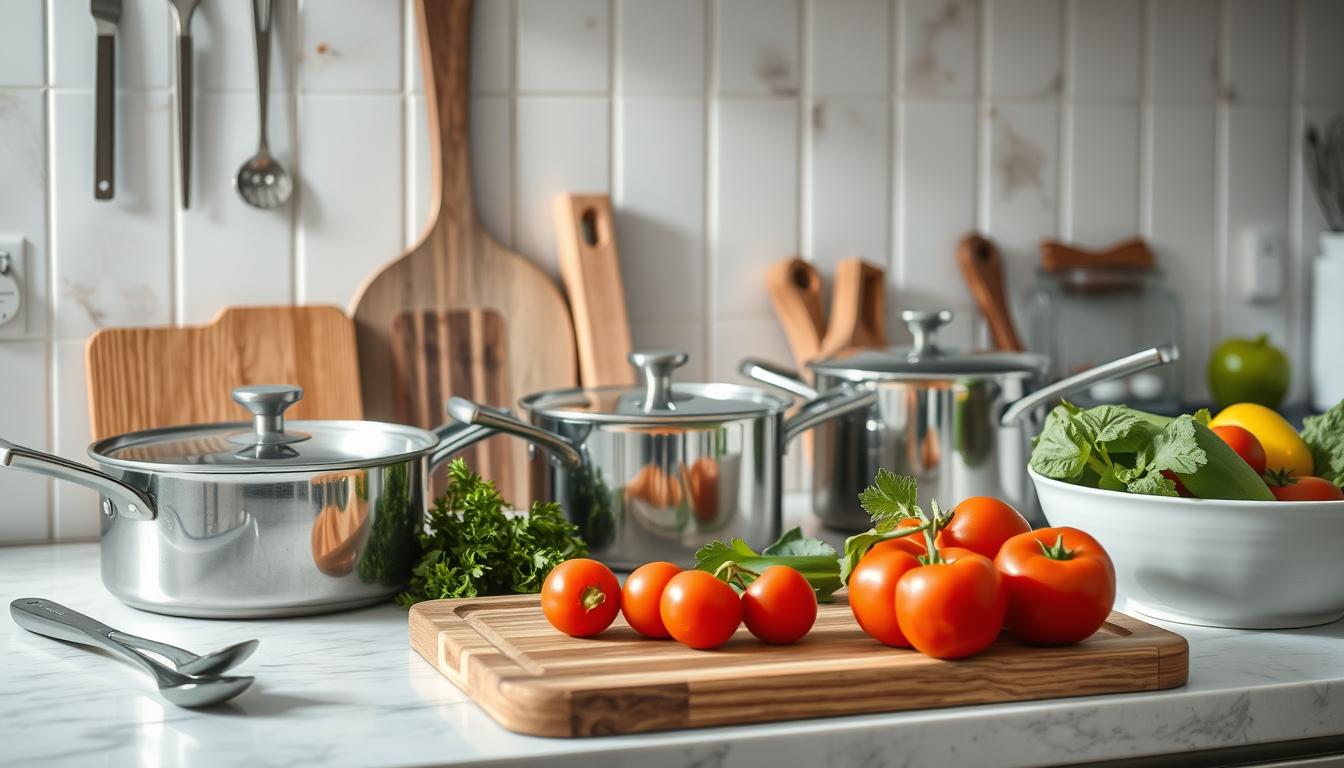Have you ever wondered if cooking is a skill reserved for the talented few, or if it’s something anyone can learn? The truth is, cooking is a skill that can be mastered by anyone with the right guidance and practice. Mastering fundamental cooking techniques is more valuable than memorizing individual recipes, as it empowers you to create a wide variety of dishes with confidence.
Learning to cook is one of the most important life skills, allowing you to make cooking easy and enjoyable. By focusing on beginner cooking tips, you can start your culinary journey on the right foot. It’s about understanding the basics and building upon them.
Key Takeaways
- Mastering basic cooking techniques is key to becoming a confident cook.
- Understanding the fundamentals allows you to experiment with various recipes.
- Starting with simple recipes helps build your cooking confidence.
- Practicing regularly is crucial to improving your cooking skills.
- Investing in a few essential kitchen tools can make cooking easier.
Understanding the Basics of Cooking
Before you can experiment with complex recipes, you need to understand the foundation of cooking. This involves grasping the importance of using fresh ingredients and familiarizing yourself with basic cooking terminology.
The Importance of Fresh Ingredients
Using fresh ingredients is crucial for creating dishes that are not only delicious but also nutritious. Fresh, seasonal ingredients often have better flavor and nutritional value. For instance, choosing vegetables that are in season ensures they’re at their peak flavor and texture.
Benefits of Fresh Ingredients:
- Better taste and texture
- Higher nutritional value
- Supports local farmers and reduces carbon footprint
When shopping for ingredients, look for vibrant colors and avoid wilted or bruised produce. For more tips on selecting the best ingredients, you can visit Epicurious, a reputable culinary website that offers expert advice.
Cooking Terminology for Beginners
Understanding basic cooking terminology is essential for following recipes and communicating with other cooks. Terms like “sauté,” “roast,” and “boil” are fundamental techniques that every home cook should know.
| Cooking Term | Description |
|---|---|
| Sauté | Cooking quickly in a pan with a small amount of oil or fat. |
| Roast | Cooking in the oven using dry heat. |
| Boil | Cooking in liquid (usually water) at a high temperature. |
For more beginner-friendly recipes and cooking techniques, consider visiting Allrecipes, a website that offers a wide range of simple and delicious meal ideas.
Essential Kitchen Tools You’ll Need
A well-stocked kitchen is the foundation of cooking made simple. Having the right tools at your disposal can make a significant difference in your cooking experience, allowing you to prepare meals efficiently and effectively.
Must-Have Utensils for Every Home Cook
Every home cook should have a set of essential utensils that make cooking easier and more enjoyable. These include a good chef’s knife, which is crucial for chopping ingredients, wooden spoons for stirring, and a metal spatula for flipping and serving. Investing in quality utensils may seem costly upfront, but they are durable and will last for a long time, making them a worthwhile investment for any kitchen.
For more insights on utensils and other kitchen essentials, you can visit our blog post on Kitchen Essentials for Beginners, which provides a comprehensive guide for those just starting out.
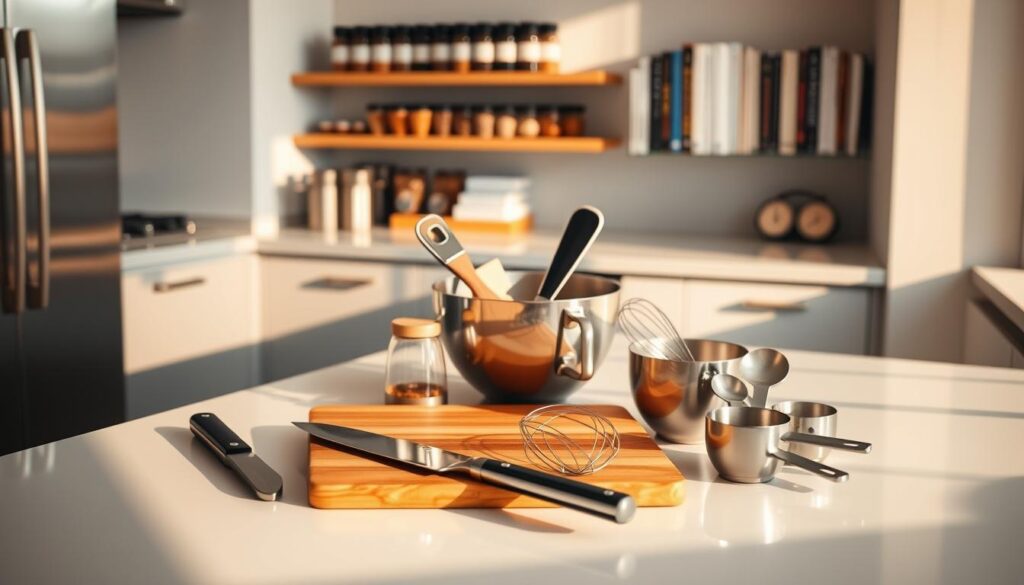
Choosing the Right Cookware
Cookware is another critical component of a well-equipped kitchen. When choosing cookware, consider the material, size, and non-stick properties. Stainless steel and cast iron are popular choices due to their durability and heat retention. Non-stick pans are ideal for cooking delicate foods like eggs and pancakes, while larger pots are necessary for cooking pasta and soups.
For tips on selecting the best cookware for your needs, check out our article on Choosing the Right Cookware, which offers expert advice and recommendations.
By equipping your kitchen with the right tools and cookware, you’ll be well on your way to becoming a confident home cook, ready to tackle a variety of recipes with ease.
Meal Planning101
Planning your meals is a simple yet powerful way to enhance your cooking skills. By doing so, you can save time, reduce food waste, and ensure that you’re preparing balanced and nutritious meals. Effective meal planning involves several key steps, starting with understanding your dietary needs and preferences.
To start planning balanced meals, consider your weekly schedule and the number of meals you need to prepare. Think about incorporating a variety of quick and easy recipes that can be prepared in under 30 minutes, as well as meals that can be cooked in advance. For more ideas on simplifying your meal planning, check out our guide on meal planning for beginners.
Tips for Planning Balanced Meals
When planning your meals, aim for a balance of protein, healthy fats, and complex carbohydrates. Include a variety of vegetables and fruits in your meals to ensure you’re getting a broad range of nutrients. Simple cooking techniques like roasting, grilling, and sautéing can help you prepare healthy meals without spending too much time in the kitchen.
- Plan your meals around seasonal produce to ensure freshness and variety.
- Consider your dietary restrictions and preferences when selecting recipes.
- Make a grocery list based on your meal plan to avoid last-minute trips to the store.
How to Create a Weekly Menu
Creating a weekly menu involves several steps, starting with identifying your meal planning goals. Decide on the number of meals you want to plan for and the type of cuisine you’re in the mood for. You can find inspiration for beginner-friendly recipes online or in cookbooks. Once you have a list of potential meals, create a calendar or list outlining your meals for the week.
By following these steps and tips, you can simplify your cooking routine and enjoy the benefits of meal planning. Whether you’re a busy professional or a cooking novice, meal planning can help you save time, reduce stress, and enjoy healthy, delicious meals.
Mastering Basic Cooking Techniques
The foundation of great cooking lies in mastering simple yet effective techniques. Understanding and applying these techniques can elevate your dishes and make cooking more enjoyable.
Boiling, Sautéing, and Roasting Explained
Basic cooking techniques such as boiling, sautéing, and roasting are fundamental to preparing a variety of dishes. Boiling involves cooking food in liquid at a high temperature, typically used for pasta, potatoes, and vegetables. Sautéing is a method that involves quickly cooking food in a small amount of oil or fat, preserving the texture and flavor of the ingredients. Roasting brings out the natural flavors of food by cooking it in the oven with dry heat, ideal for meats and root vegetables.
| Cooking Technique | Description | Best Used For |
|---|---|---|
| Boiling | Cooking in liquid at a high temperature | Pasta, potatoes, and vegetables |
| Sautéing | Quickly cooking in a small amount of oil or fat | Vegetables, meats, seafood |
| Roasting | Cooking in the oven with dry heat | Meats, root vegetables, poultry |
For more detailed explanations and recipes, you can visit reputable culinary websites like Epicurious or Food Network.
Introducing Baking Essentials
Baking is another crucial cooking technique that involves cooking food using dry heat, typically in an oven. It’s essential for making bread, cakes, pastries, and other desserts. Understanding the basics of baking, such as measuring ingredients accurately and using the right mixing techniques, can significantly improve your baked goods.
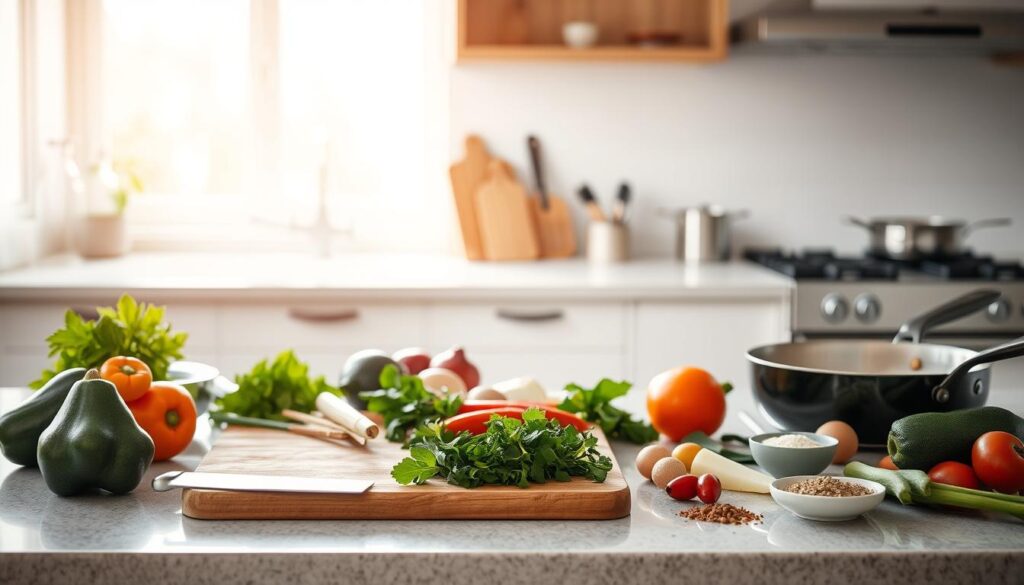
To master baking, it’s helpful to start with simple recipes and practice regularly. You can find a wealth of baking resources and recipes on websites like King Arthur Flour.
Time-Saving Cooking Hacks
Time-saving cooking hacks are essential for anyone looking to simplify their meal prep routine. With a few simple strategies, you can reduce cooking time and enjoy delicious meals without the hassle.
One-Pot Meals for Busy Schedules
One-pot meals are a lifesaver for busy home cooks. They offer a convenient way to prepare a complete meal with minimal cleanup. As Julia Child once said,
“The only time to eat diet food is while you’re waiting for the steak to cook.”
One-pot meals can be just as satisfying, with dishes like skillet pasta, chili, or stir-fries that are ready in under 30 minutes.
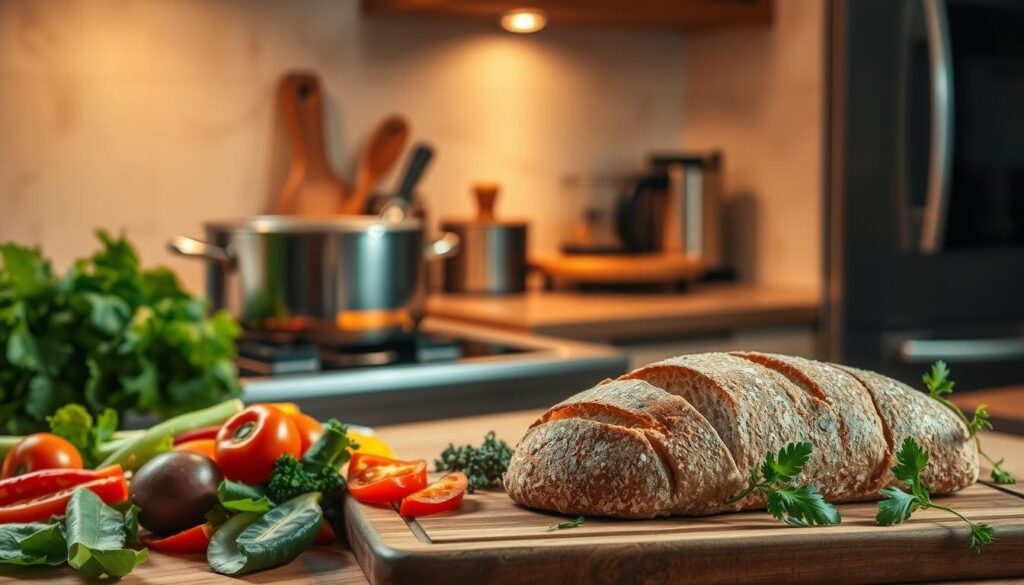
To make the most of one-pot meals, choose recipes with minimal ingredients and straightforward instructions. You can also prep ingredients in advance to make the cooking process even smoother.
Prepping Ingredients in Advance
Prepping ingredients in advance is another effective time-saving strategy. By chopping vegetables, marinating proteins, and measuring out spices ahead of time, you can significantly reduce cooking time during the week. Consider dedicating a few hours on the weekend to meal prep, and you’ll be rewarded with stress-free cooking throughout the week.
- Chop vegetables and store them in airtight containers.
- Marinate proteins like chicken or tofu for quick cooking.
- Measure out spices and seasonings for each recipe.
By incorporating these time-saving cooking hacks into your routine, you’ll be able to enjoy home-cooked meals without the extra stress. As you become more comfortable in the kitchen, you can experiment with new recipes and techniques, further expanding your culinary repertoire.
Flavoring Your Dishes Like a Pro
Flavoring your dishes like a professional chef is easier than you think, and it all begins with a few simple techniques. Mastering the art of flavoring can elevate your meals from ordinary to extraordinary. In this section, we’ll explore the essentials of understanding herbs and spices, as well as simple sauces that can enhance any meal.
Understanding Herbs and Spices
Herbs and spices are the backbone of any cuisine, providing the depth and complexity that make a dish memorable. Understanding the difference between herbs and spices is crucial. Herbs are the leaves of plants, used fresh or dried, while spices are derived from other parts of the plant, such as seeds, bark, or roots.
For beginners, starting with common herbs like basil, rosemary, and thyme can be a great way to add flavor to dishes. For more information on using herbs in cooking, you can visit our post on herbs in cooking. Spices like cumin, coriander, and paprika can add warmth and depth. Experimenting with different combinations can help you develop your signature flavor.
| Herb/Spice | Common Use | Flavor Profile |
|---|---|---|
| Basil | Pesto, Italian dishes | Sweet, aromatic |
| Cumin | Mexican, Indian dishes | Warm, earthy |
| Rosemary | Roasted meats, vegetables | Piney, herbaceous |
Simple Sauces to Enhance Any Meal
Sauces can transform a simple dish into something spectacular. Starting with a few basic sauces can greatly enhance your cooking repertoire. Consider making a simple tomato sauce for pasta, a bechamel sauce for creamy dishes, or a salsa for a fresh, tangy flavor.
For a quick and easy sauce, try our recipe for simple tomato sauce. You can also experiment with different ingredients to create your signature sauces.
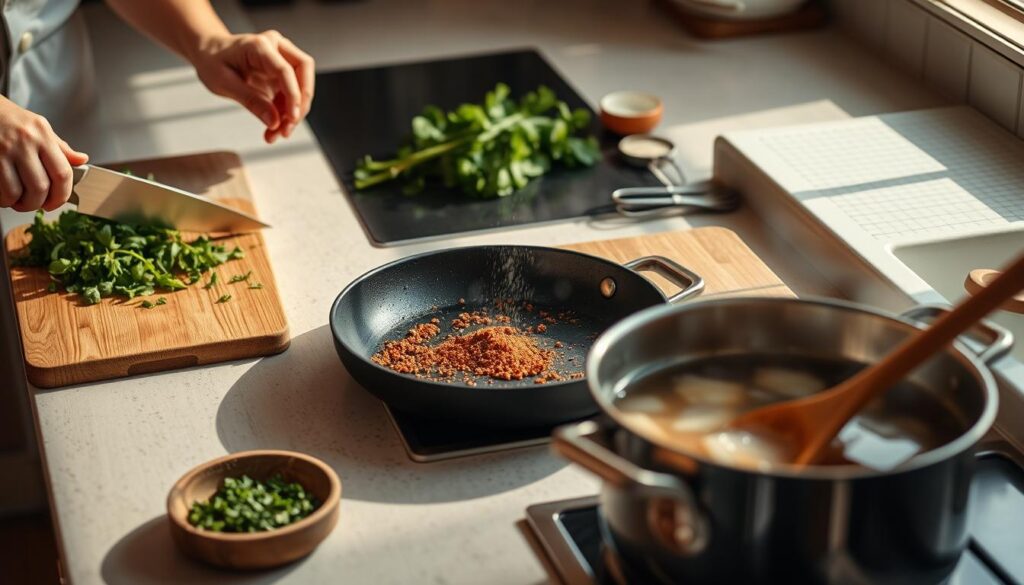
By understanding and applying these simple techniques, you’ll be well on your way to flavoring your dishes like a pro. Remember, the key to great flavor is experimentation and practice.
Cooking with Safety in Mind
As you start your cooking journey, it’s crucial to prioritize kitchen safety to avoid accidents. A safe kitchen environment not only protects you from potential hazards but also ensures a more enjoyable cooking experience.
Kitchen Safety Tips for Beginners
To maintain a safe kitchen, start by being mindful of your surroundings and the tools you’re using. Here are some essential kitchen safety tips:
- Always keep a fire extinguisher in the kitchen and know how to use it.
- Use sharp knives and cutting boards correctly to prevent cuts.
- Be cautious with hot surfaces and open flames.
- Keep the kitchen floor clear of clutter to avoid slipping.

Food Storage Best Practices
Proper food storage is vital for maintaining the quality and safety of your food. Here are some best practices:
| Food Type | Storage Location | Storage Tips |
|---|---|---|
| Raw Meat, Poultry, and Seafood | Bottom shelf of the refrigerator | Store in covered containers to prevent leakage. |
| Fruits and Vegetables | Refrigerator crisper drawers or on countertops | Keep fruits and vegetables separate to prevent ethylene production from affecting spoilage. |
| Dry Goods (Pasta, Rice, etc.) | Cool, dry place in airtight containers | Label containers for easy identification and to prevent pest infestation. |
By following these food storage best practices, you can significantly reduce the risk of foodborne illnesses and keep your kitchen organized.
Finding Reliable Recipes
For those new to cooking, finding recipes that are both easy to follow and yield delicious results is crucial. The abundance of recipes available online can be overwhelming, but there are strategies to identify trustworthy sources.
One of the best places to start is reputable culinary websites. Sites like popular recipe blogs offer a curated selection of recipes that cater to various tastes and dietary needs. These platforms often feature recipes from experienced chefs and home cooks, providing a wealth of information for beginners.
Where to Look for Beginner-Friendly Recipes
Beginner-friendly recipes can be found on various online platforms. Some top recommendations include:
- Cooking blogs that specialize in simple, easy-to-follow recipes
- Culinary websites that offer a wide range of recipes, from basic to advanced
- Social media platforms where home cooks and professional chefs share their favorite recipes
When exploring these sources, look for recipes with clear instructions, ingredient lists, and nutritional information. This will help you understand not just the ‘how’ but also the ‘why’ behind certain cooking techniques.
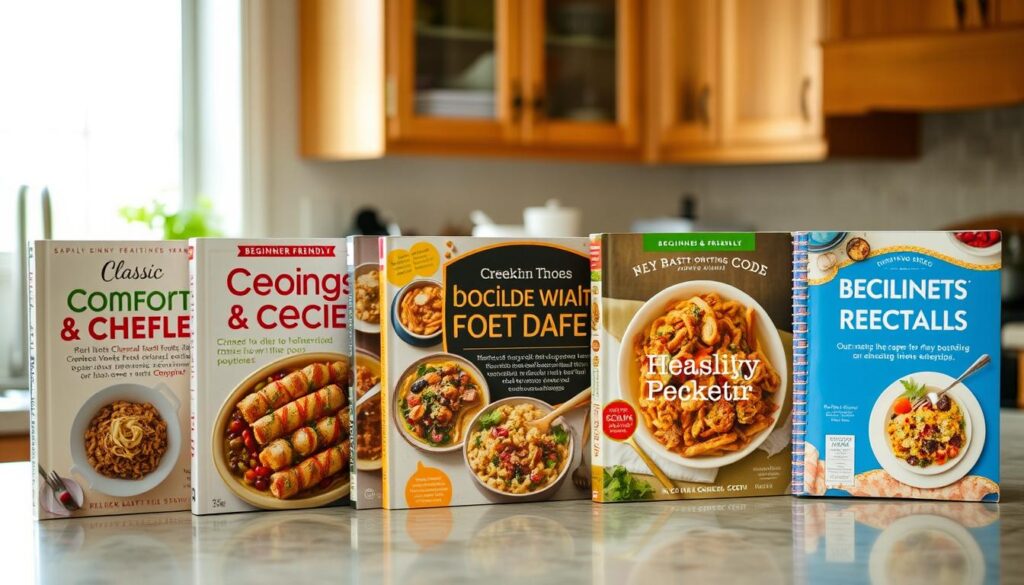
Understanding Recipe Measurements
Understanding recipe measurements is essential for achieving the desired outcome. Recipes often list ingredients in specific quantities, and using the correct measurements is crucial. Here are some tips:
- Familiarize yourself with common cooking measurements, such as teaspoons, tablespoons, and cups.
- Invest in a digital kitchen scale for accurate weight measurements.
- When a recipe calls for a specific ingredient quantity, try to adhere to it as closely as possible.
By mastering recipe measurements and finding reliable sources for beginner-friendly recipes, you’ll be well on your way to enhancing your cooking skills and exploring new culinary horizons.
Embracing the Art of Experimentation
The art of cooking is not just about following recipes, but also about experimenting and innovating. As you become more comfortable in the kitchen, you’ll find that trying new things and making adjustments on the fly is where the real magic happens. This is where you can truly make cooking easy and fun, even for beginners.
Experimenting with new recipes and ingredients is a great way to develop your cooking skills and discover your cooking hacks for beginners. It’s about understanding the basics and then feeling confident enough to deviate from them. By doing so, you’ll not only enhance your culinary knowledge but also make the cooking process more enjoyable.

Substituting Ingredients with Confidence
One of the key aspects of experimenting in the kitchen is learning how to substitute ingredients with confidence. This could be due to dietary restrictions, ingredient availability, or simply personal preference. Understanding the role of each ingredient in a recipe allows you to make informed substitutions that won’t compromise the dish’s integrity.
For instance, if a recipe calls for a specific type of milk, knowing the differences between almond milk, soy milk, and coconut milk can help you choose the best substitute based on the desired flavor and texture. Similarly, being aware of the different types of flour and their uses can help you adjust recipes accordingly. This kind of knowledge is essential for cooking tips for beginners who want to make cooking easy and flexible.
When to Stick to the Recipe versus When to Improvise
While experimentation is encouraged, there are times when sticking to a recipe is advisable, especially for beginners. Recipes that involve precise chemical reactions, like baking, often require strict adherence to ingredient ratios and types. However, dishes like stir-fries or salads offer more flexibility and are great opportunities to practice improvising.
The key is to understand the recipe’s core elements and then decide where you can safely make adjustments. As you gain more experience, you’ll develop a sense of when to stick to the recipe and when you can improvise, making cooking hacks for beginners a valuable tool in your culinary journey.
By embracing the art of experimentation and learning to substitute ingredients and improvise, you’ll not only enhance your cooking skills but also make the cooking process more enjoyable and rewarding. This approach will help you make cooking easy and fun, even as you explore more complex recipes and techniques.
Building Confidence in the Kitchen
As you continue on your culinary journey, building confidence in the kitchen is essential. By mastering basic cooking techniques, understanding kitchen safety, and experimenting with new recipes, you’ll become more comfortable and proficient in the kitchen.
Overcoming Common Cooking Fears
Don’t let fear hold you back from trying new beginner-friendly recipes. Start with simple dishes and gradually work your way up to more complex meals. With practice, you’ll develop the skills and confidence to tackle any recipe.
Continuing Your Culinary Journey
To continue improving your cooking skills, try new ingredients, techniques, and recipes. Explore different cuisines, such as Italian or Asian cooking, and experiment with new flavors and ingredients. For easy cooking tips and inspiration, visit reputable cooking websites and blogs.
Frequently Asked Questions: What are some essential beginner cooking tips? Start with simple recipes and practice basic cooking techniques. How do I find beginner-friendly recipes? Look for recipes labeled “easy” or “beginner-friendly” on cooking websites and blogs. What are some common cooking mistakes to avoid? Be mindful of overcooking, under-seasoning, and kitchen safety.
FAQ
What are the essential kitchen tools for a beginner?
As a beginner, you’ll need basic utensils like a chef’s knife, a cutting board, and pots and pans. Investing in a good quality cookware set and utensils like a silicone spatula and tongs can make cooking easier. For more information, check out our guide on essential kitchen tools.
How do I choose the right ingredients for a recipe?
Choosing the right ingredients involves selecting fresh produce, meats, and spices. Understanding cooking terminology and recipe measurements can also help. For tips on selecting the best ingredients, visit our section on understanding the basics of cooking.
What are some simple cooking techniques for beginners?
Basic cooking techniques like boiling, sautéing, and roasting are great for beginners. Mastering these techniques can help you prepare a variety of dishes. For more information, check out our guide on mastering basic cooking techniques.
How can I save time while cooking?
Time-saving cooking hacks like one-pot meals and prepping ingredients in advance can make cooking more efficient. For more tips, visit our section on time-saving cooking hacks.
What are some beginner-friendly recipes?
You can find beginner-friendly recipes on reputable culinary websites and cooking blogs like Cookflare Recipes. Understanding recipe measurements and cooking terminology can also help. For more information, check out our guide on finding reliable recipes.
How can I improve my cooking skills?
Practicing basic cooking techniques, experimenting with new ingredients, and learning from mistakes can help improve your cooking skills. For more tips, visit our section on building confidence in the kitchen.
What are some common kitchen safety tips for beginners?
Kitchen safety tips like handling knives safely, keeping the kitchen clean, and storing food properly can help prevent accidents. For more information, check out our guide on cooking with safety in mind.
How can I make meal planning easier?
Meal planning involves planning balanced meals, creating a weekly menu, and making a grocery list. For more tips, visit our section on meal planning 101.
What are some simple ways to flavor my dishes?
Understanding herbs and spices, using simple sauces, and experimenting with different seasonings can help enhance the flavor of your dishes. For more information, check out our guide on flavoring your dishes like a pro.

